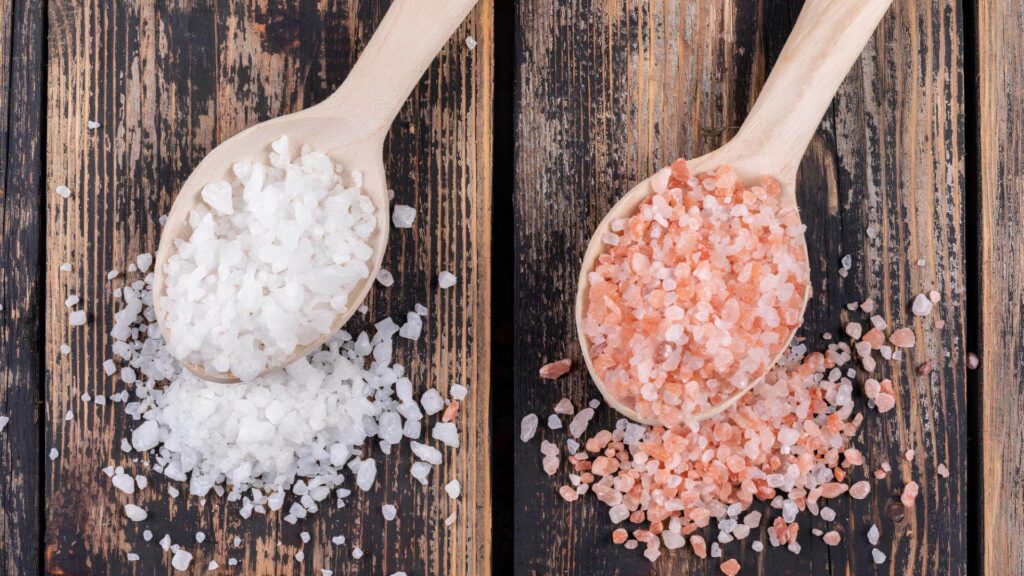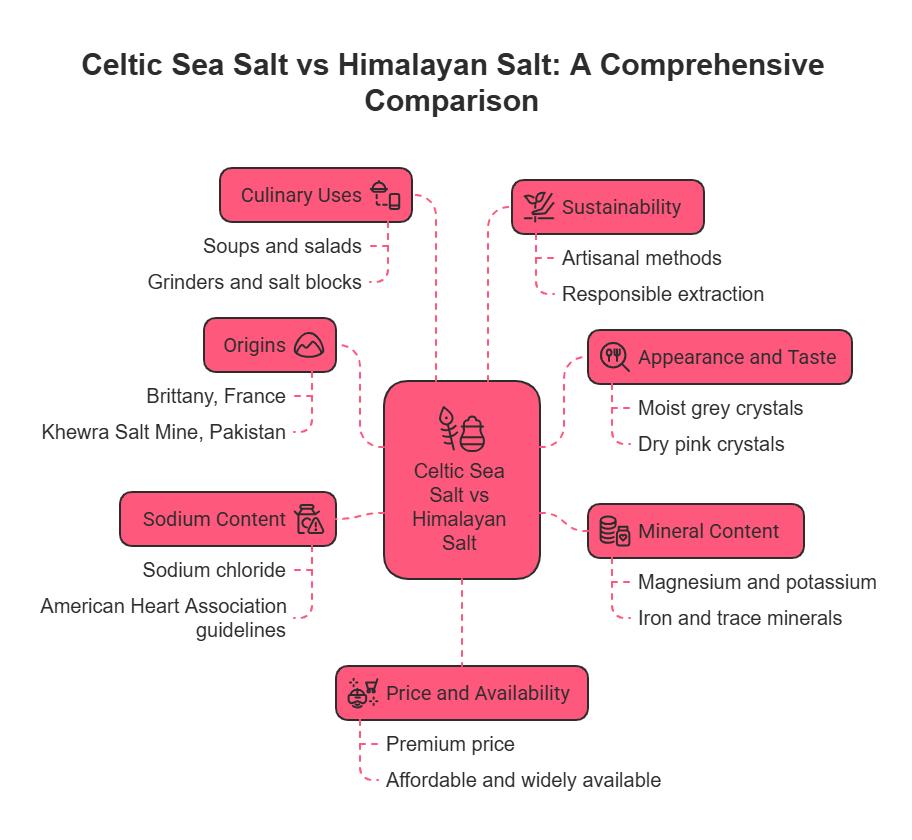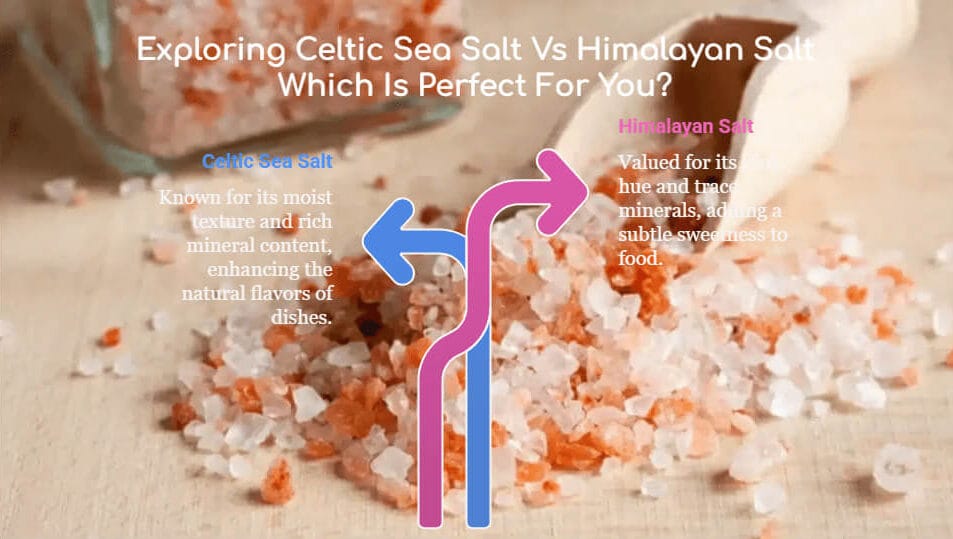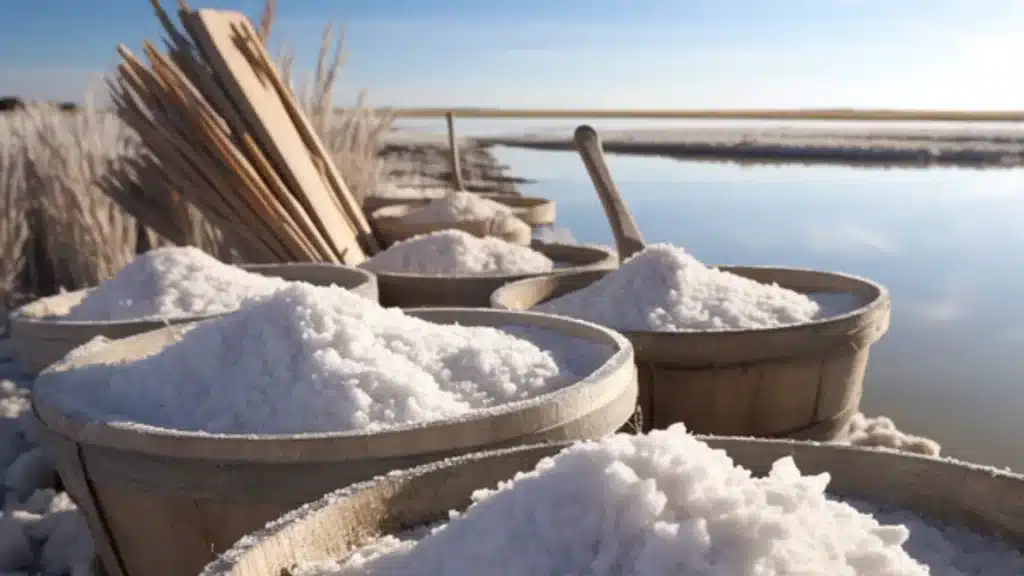
These two salts have captured interest in kitchens, wellness routines and even natural health. Between Celtic sea salt versus Himalayan salt families wonder which is better for cooking or health. This guide will help you compare origins, taste, mineral content, sodium safety, culinary uses and sourcing so you can make a smart choice for your loved ones.
Table of Contents

Origins and How They Are Made
Celtic sea salt comes from coastal ponds in Brittany, France. Harvesters rake it by hand from clay‑lined salt beds after seawater evaporates. The clay gives it a moist, slightly grey appearance and helps preserve its natural minerals.
Himalayan salt is mined in Pakistan from ancient rock salt deposits in the Khewra Salt Mine deep in the Salt Range Mountains. The pink crystals form naturally from mineral-rich deposits and are extracted with care by hand.
Appearance Taste and Texture Comparison
Celtic sea salt displays a soft grey hue and moist texture. Its taste is gently briny with a subtle umami complexity that pairs beautifully with fresh salads, soups and roasted vegetables.
Himalayan salt has dry pink to reddish crystals with a firm, crunchy structure. It carries an earthy flavor and is often used as a finishing salt or in grinders and salt blocks for cooking.
Mineral Content Hydration and Health
Both Celtic sea salt and Himalayan salt contain trace minerals such as magnesium potassium calcium and iron. Celtic sea salt tends to have higher magnesium and potassium levels while Himalayan salt has more iron, giving it a pink color.
That said, the amount of these minerals in a typical pinch of salt is small. Neither salt delivers meaningful nutrition in daily sodium use.
Many people have tried adding a pinch of Celtic sprinkle to water for hydration. However experts note that electrolytes are best obtained through whole foods, hydration pieces of salt can increase sodium intake which may affect heart health.
Sodium Content and Guidance for Families

Both Celtic sea salt and Himalayan salt are primarily sodium chloride. By weight they contain nearly the same amount of sodium. Coarse granules may seem less dense but when measured by volume they deliver similar levels.
Excess sodium intake can raise blood pressure and cardiovascular risk. Children pregnant individuals or those with existing health conditions should be cautious. The American Heart Association recommends keeping sodium under 2300 mg per day with an ideal goal closer to 1500 mg for many adults. This applies whether choosing Celtic or Himalayan salt.
Read More: Rock Salt Vs Sea Salt Which Salt Is Best For You?
Culinary Uses in Everyday Cooking
Celtic sea salt works well for cooking and finishing. Its moist crystals dissolve easily and bring a softer crunch. It enhances soups, stews, salads and grilled vegetables.
Himalayan salt is often used in grinders for seasoning steamed foods roasted or sprinkled on dishes after cooking. Salt blocks made from Himalayan salt are popular for grilling and plating. You might also like to read How Use Himalayan Salt For Cooking.
Sustainability and Ethical Sourcing
Celtic sea salt is harvested using traditional artisanal methods with minimal environmental disruption. Local communities in coastal France benefit from the sustainable small‑scale process.
Himalayan salt mining has a larger environmental footprint due to transport from Pakistan and scale of operations. That said, ethical producers follow responsible practices during extraction. Choosing trusted brands like Sobaan Salts to ensure proper sourcing.
Price Availability and Value
Celtic sea salt is often sold at a premium price due to handmade production and import costs. However a little goes a long way because of flavor and moisture content.
Himalayan salt is more widely available and tends to be more affordable. It remains popular in both retail and bulk formats, especially for use in wellness and culinary products.
Real Family Scenarios Choosing the Right Salt

- If your family loves bold roasted dishes salads or wants a salt that dissolves quickly with a mineral finish choose Celtic sea salt.
- If you prefer a visually appealing salt that works great in grinders salt blocks or paired with wellness use choose Himalayan Pink salt.
In both cases your main priority should be moderation balanced recipes and awareness of total sodium intake from all sources.
Final Recommendation Which Salt Is Better for Your Family
Between sea salt vs Himalayan salt, the best choice depends on your priorities.
Celtic sea salt offers unique moisture depth and mineral balance for everyday cooking especially in soups sauces and as finishing salt. It supports hydration though moderation in sodium is crucial.
Himalayan salt offers visual beauty, firm texture and versatility in gourmet cooking or wellness applications like bath salts, salt blocks and ritual use. Its mineral content and pink shade draw many cooks and health‑minded consumers.
Expert Perspective and Evidence‑based View
Experts emphasize that both Celtic and Himalayan salts add variety and complexity to food but should not replace whole foods or iodized salt for essential nutrients. The health impact of their additional minerals is minimal compared to dietary sources like vegetables, legumes, nuts and dairy.
Health professionals caution against trendy salt water routines where excess consumption may backfire especially for heart health. Salt is essential but should always be used mindfully.
Quick Comparison Table: Celtic Sea Salt vs Himalayan Salt
Feature | Celtic Sea Salt | Himalayan Salt |
Origin | Coastal ponds in Brittany France | Salt mines in Pakistan |
Color and Texture | Moist grey crystals | Dry pink crystals |
Flavor | Briny umami | Earthy mild |
Minerals | Rich in magnesium and potassium | Rich in iron oxide and trace minerals |
Best Use | Cooking and finishing dishes | Grinders salt blocks wellness use |
Environmental Impact | Low footprint artisanal | Larger footprint but ethical producers |
Price | Premium | More affordable |
Sodium level | Comparable by weight | Comparable by weight |
Final Thoughts From Our Family Kitchen
Both Celtic sea salt and Himalayan salt bring unique benefits to your table. If your family values strong flavor, natural moisture, and cooking versatility, choose Celtic sea salt. If you want an elegant pink salt that works beyond cooking in wellness and presentation, choose Himalayan salt. Sobaan Salts, a Trusted Himalayan salt exporter, offers high-quality options for homes and businesses alike. With mindful use and a balanced diet, either one supports food enjoyment without compromising health.
According to the Global Salt Market report, the worldwide salt market reached nearly $26 billion in 2024, with an expected growth to over $36 billion by 2032, reflecting a strong demand for both sea salt and Himalayan salt varieties. Source (Fortune Business Insights)
References:
- French sea salt contains higher levels of minerals like magnesium and potassium because it is unrefined. Health Line
- Pink Himalayan salt consists of up to 98 percent sodium chloride, with the remaining portion made up of trace minerals such as potassium, magnesium, and calcium. Medical News Today
- Sea salt and table salt have the same sodium content by weight, though sea salt is typically less processed and retains more natural minerals. Mayo Clinic
Share This Post
Article By

